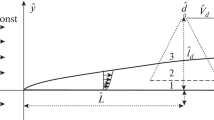Abstract
Transverse force and yaw moment acting on a surface-piercing flat plate with yaw angle and forward speed are studied. Following the Froude hypothesis, the problem is decomposed into a tail-separated forward flow and a bottom-tip-separated cross-flow parts. The objective is to quantify the role of different components in the resulted force and moment acting on the plate. A 3D potential flow code using distribution of Rankine sources and dipoles is used to solve the linear potential flow problem. The free-surface boundary condition is linearized based on the undisturbed flow velocity (Neumann–Kelvin linearization). The plate’s trailing-edge flow separation is modeled using a dipole distribution behind the plate on a linearized vortex sheet. The force and moment due to the cross-flow separation from the plate’s bottom tip are calculated by means of a slender body cross-flow method with a rigid free-surface boundary condition. Hence the free-surface effects are confined in the forward flow problem and neglected in the cross-flow problem. Simulations are carried out for different aspect ratios and drift angles. The plate’s thickness is taken into account. Convergence and sensitivity studies are performed carefully. Results are compared with previous experimental and numerical studies. The importance of the second-order forces and validity of the linear assumptions are touched upon. The overall agreement of the results is acceptable. The relative importance of the two viscous and potential components are studied. It is shown that the decomposed problem could follow the experimental results up to a relatively high Froude number.























Similar content being viewed by others
References
van den Brug JB, Beukelman W, Prins GJ (1971)Hydrodynamic forces on a surface piercing flat plate. Tech. Rep. 325, Delft University of Technology, Ship Building Labratory
Bunnik T (1999) Seakeeping calculations for ships, taking into account the non-linear steady waves. Ph.D. thesis, Delft University of Technology
Chapman RB (1976) Free-surface effects for yawed surface-piercing plates. J Ship Res 20(3)
Faltinsen OM (2005) Hydrodynamics of high-speed marine vehicles. Cambridge University Press
Faltinsen OM, Pettersen B (1983) Vortex shedding around two-dimensional bodies at high reynolds number. In: 14th symposium—naval hydrodynamics, Natl. Acad. Press, Ann Arbor, pp 1171–1213
Fink P, Soh W (1974) Calculation of vortex sheets in unsteady flow and applications in ship hydrodynamics. In: Proceedings of the 10th symposium on Naval Hydrodynamics. Cambridge, Massachusetts
Gregory N, O’Reilly CL (1973) Low-Speed aerodynamic characteristics of NACA 0012 aerofoil section, including the effects of upper-surface roughness simulating hoar frost. Tech. Rep. 3726, Aerodynamics Division N.P.L., London
Kashiwagi M (1983) On the stability derivatives of high speed ships oscillating in low frequency. J Kansai Soc Naval Arch
Koumoutsakos P, Shiels D (1996) Simulations of the viscous flow normal to an impulsively started and uniformly accelerated flat plate. J Fluid Mech 328:177–227
Kristiansen T (2009) Two-dimensional numerical and experimental studies of piston-mode resonance. Ph.D. thesis, Norwegian University of Science and Technology, Department of Marine Technology, Trondheim
Landrini M, Campana E (1996) Steady waves and forces about a yawing flat plate. J Ship Res 40(3):179–192
Maniar HD, Newman JN, Xü H (1990) Free-surface effects on a yawed surface-piercing plate. In: Eighteenth symposium on naval hydrodynamics, Ann Arbor
Mantic V (1993) A new formula for the c-matrix in the somigliana identity. J Elast 33(3):191–201
Morino L, Kao C (1974) Subsonic potential aerodynamics for complex configurations: a general theory. AIAA J 12(2):191–197
Nakos D (1990) Ship wave patterns and motions by a three dimentional rankine panel method. Ph.D. thesis, Massachusetts Institute of Technology
Shao Y (2010) Numerical potential-flow studies on weakly-nonlinear wave-body interactions with/without small forward speeds. Ph.D. thesis, Norwegian University of Science and Technology, Department of Marine Technology, Trondheim
Thompson JF, Soni BK, Weatherill NP (1999) Handbook of grid generation. CRC Press
Tønnessen R (1999) A finite element method applied to unsteady viscous flow around 2D blunt bodies with sharp corners. Ph.D. thesis, Norwegian University of Science and Technology, Department of Marine Technology, Trondheim
Xü H (1991) Potential flow solution for a yawed surface-piercing plate. J Fluid Mech 226:291–317
Zhu W, Faltinsen OM (2007) Towards numerical dynamic stability predictions of Semi-Displacement vessels. In: Proceedings of the 9th International conference on fast sea transportation, Shanghai
Acknowledgments
This work was supported by the Research Council of Norway through the Centres of Excellence funding scheme AMOS, project number 223254 and CeSOS.
Author information
Authors and Affiliations
Corresponding author
About this article
Cite this article
Ommani, B., Faltinsen, O.M. Viscous and potential forces on an advancing surface-piercing flat plate with a fixed drift angle. J Mar Sci Technol 20, 278–291 (2015). https://doi.org/10.1007/s00773-014-0282-1
Received:
Accepted:
Published:
Issue Date:
DOI: https://doi.org/10.1007/s00773-014-0282-1




